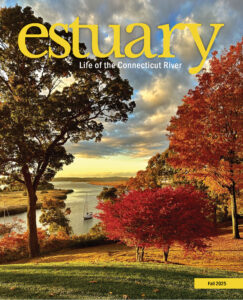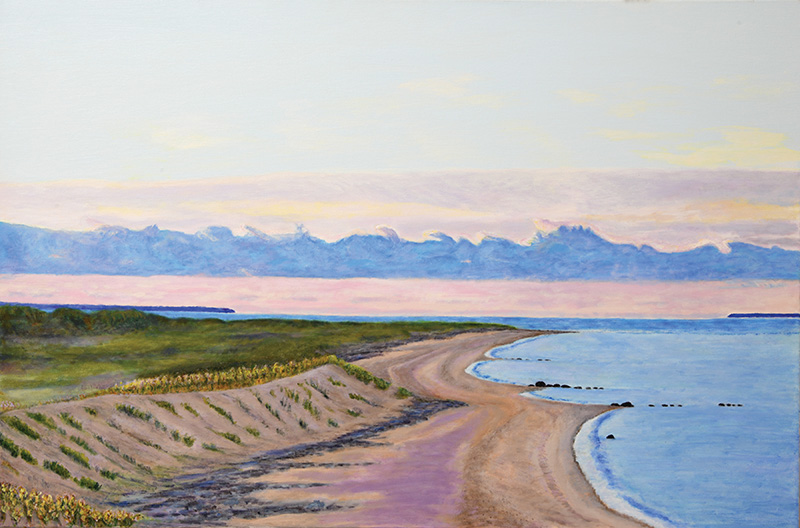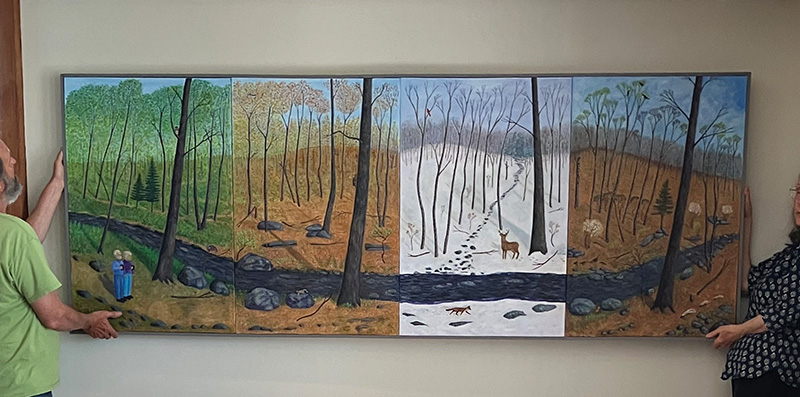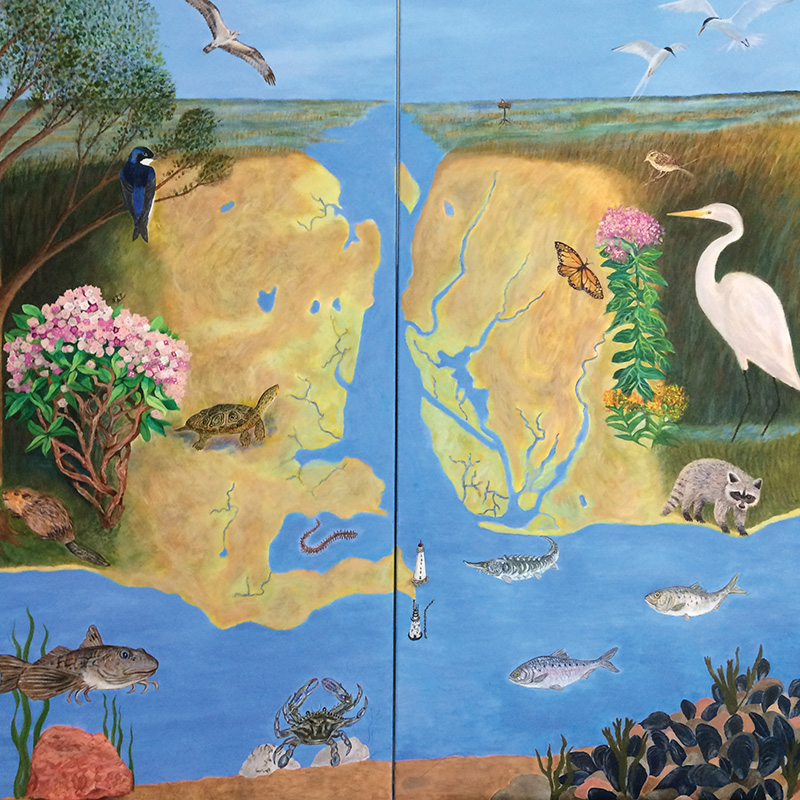 This article appears in the Fall 2025 issue
This article appears in the Fall 2025 issue

Image Credit: Emily Bernhardt
By Janet Roach
Please meet one of the Connecticut River valley’s true (and mostly unsung) heroes: the artist John H. Sargent of Quaker Hill, Connecticut. For more than ten years, Sargent has devoted endless hours to creating paintings that both engage and educate all those who are lucky enough to see them, nearly always as a donation to an organization or cause he cares about. Cheerful, modest, and soft-spoken, Sargent often has several projects at various stages of development.
His work is—or soon will be—exhibited at The Nature Conservancy’s Burnham Brook property in East Haddam, Connecticut (where the East Haddam Land Trust and other nonprofits have offices); the Waterford Public Library; the Connecticut River Conservancy’s Greenfield, Massachusetts, headquarters; Connecticut Audubon Society’s Roger Tory Peterson Estuary Center in Old Lyme, Connecticut; the National Estuarine Research Reserve System office at UConn (University of Connecticut) Avery Point campus in Groton, Connecticut; and the New Haven offices of Save the Sound.
“I am fortunate,” Sargent writes, “that throughout my life I have been able to spend a lot of time outdoors in natural areas that I could roam around and explore. I view nature in terms of aesthetics, design, and color. More recently I have been observing and studying with a more scientific eye the details of the natural environment.”
As Sargent’s life and work reminds us, art and environmental conservation have long been intertwined. Over a century ago, in June 1864 in the midst of the grim sorrows of the Civil War, President Abraham Lincoln took a brief time-out from his more onerous duties to sign into law an act protecting a slice of land “in the granite peaks of the Sierra Nevada Mountains.” It was the federal government’s first-ever effort to preserve a natural habitat for the common good. The protected area was then known as Yo-Semite Valley. It is now Yosemite National Park which conserves an area about the size of Rhode Island.
Yosemite might never have happened but for the work of a little-known artist/photographer named Carleton Watkins. In the summer of 1861, Watkins set out to photograph the wonders of Yosemite Valley. A mule train carried a load of gear—Watkins’s camera, tripods, lenses, glass plate negatives, a dark tent, and development equipment. Half Dome, Cathedral Rock, and El Capitan became his subjects. California Senator John Conness collected a number of Watkins’s prints and brought them to the attention of his friend, President Lincoln.
Like Yosemite and many other prized scenic areas around the nation and the world, the Connecticut River has inspired its share of writers, artists, birders, wildflower hunters, fishermen, and all sorts of naturalists to make common cause of preserving and protecting the river and environs, Sargent among them.
The mule train is gone, but Sargent today carries sketch pads and drawing equipment into the field to capture his subjects—from the Connecticut River’s mouth to its headwaters in northern Vermont.
Now in his seventies, Sargent grew up in Hartford and spent summers on a spit of land jutting into Long Island Sound just east of the mouth of the same great river. His first artistic efforts came when he was about eight and absent from school because of illness. To wile away the time, he carved animals—bears, dogs—from bars of soap and made castles out of discarded cardboard.
Sargent credits his father’s father, for whom he was named, with encouraging his artistic pursuits. “He was a fine observer of nature who particularly appreciated wildflowers and native trees,” writes Sargent in the online portfolio of his work (www.johnhsargent.com). Among other things, his grandfather gave him an exquisite pencil drawing he’d made, “Oriole Nest in Blossoming Laurel.” It remains one of Sargent’s most treasured possessions.
By the time he was in middle school, Sargent knew he wanted to spend his life as an artist. “Attending a high school with a strong art department was good preparation for more advanced learning,” he said. He went on to earn a BFA at Ohio Wesleyan University. Then, after a stint in Georgia as a community service provider working in a low-income neighborhood, he and his brother bought a farm in rural Quebec. “The long winters provided abundant time to do artwork,” he remembered. In addition to painting and drawing, mostly related to his work on the farm, Sargent learned to carve soapstone, a tradition of the Indigenous people of the area.
Why did he return to Connecticut? “To find a mate,” Sargent exclaims with an impish grin. And find he did. He and his wife, Linda, met at a Nuclear Freeze conference in New Haven and married in 1986. Now, to tour their New London, Connecticut, home and studio with Linda as his docent is to take a trip through Sargent’s development as an artist. She proudly points out paintings that were inspired not only from local vistas but from trips to China, the Virgin Islands, Peru, and Scotland.
“Nature,” says John Sargent, “has always been a key element in my art.” But his first foray into linking his art to the conservation movement was inspired by his parents’ involvement with Save the Sound, which leads environmental efforts in Long Island Sound and environs. In about 2005 his parents, David and Jean Sargent, joined in opposition to the Broadwater Liquid Natural Gas tank storage area proposed for the middle of Long Island Sound. That led to their joining in the effort to conserve a nearly thousand-acre parcel predominantly in Old Saybrook, Connecticut. In 2012 John joined some of the same people in the effort to conserve Plum Island, a former animal disease research center about ten nautical miles south of the mouth of the Connecticut River and an important refuge on the North Atlantic flyway for migratory birds.

“Piney Point on Plum Island,” acrylic, 2016, by John H. Sargent. Image Credit: Vincent Scarano painting).
Because Plum Island was closed to the public, the only way to acquaint people with its beauty and to create interest in preserving it was to get and show pictures. Sargent was just the man. He teamed up with photographer Robert Lorenz, a long-time member of the Old Saybrook Land Trust, to document the natural beauty of Plum Island. The exhibition they created in 2014 consisted of thirty paintings and pastels by Sargent and twenty-four photographs by Lorenz. The show travelled to more than fifteen public sites in southeastern Connecticut.
“We protect what we love,” says Laura McMillan of Save the Sound, stating plainly the mission that drives John Sargent. All the years Sargent has spent along the river, starting from childhood, “have cultivated a lot of fondness and passion to help protect the overall environment of this largest-in-Connecticut watershed,” he notes.

“Burnham Brook Through Four Seasons” by John H. Sargent for The Nature Conservancy’s Burnham Brook Preserve in East Haddam, CT, being hung. Image Credit: Elsbeth Gentile
Sargent’s most recently completed project is the four-panel mural for The Nature Conservancy’s Burnham Brook Preserve. Each panel depicts one season, with the brook running through all four. The preserve was donated to the conservancy by Richard and Esther Goodwin. Richard Goodwin, who taught biology at Connecticut College, was a strong advocate for environmental causes and a particular hero and role model to Sargent. Having Sargent’s work hang in what was the Goodwin house seems like a convergence of forces for the common good. (Read our profile of Richard Goodwin, “The Pied Piper of Land Conservation,” by David Holahan in the Winter 2023 issue and online.)
Such is the approach to work and life that John and Linda share as they work toward capturing the beauty of the world around them and helping to protect and preserve it—just like Carleton Watkins and all the other artist/environmentalists who’ve devoted their creative lives to conservation.
Janet Roach is Professor Emeritus, Columbia University. She taught writing at the Graduate School of the Arts and had earlier careers as a journalist and Hollywood screenwriter.
Current and Upcoming Exhibitions
Burnham Brook Preserve Paintings by John H. Sargent and Tribute to Richard and Esther Goodwin
September 2–29, 2025
Waterford Public Library
49 Rope Ferry Road
Waterford, CT 06385
In honor of Richard and Esther Goodwin, a special exhibition in cooperation with the Nature Conservancy’s
Burnham Brook Preserve and the Connecticut College Arboretum. The Goodwins created the Burnham Brook
Preserve in East Haddam, CT, and donated the land to the Nature Conservancy. Richard Goodwin was a former director of the arboretum and helped facilitate the expansion and organization of the arboretum.
Connecticut River “Source to Mouth” Painting Project
October 6–30, 2025
Reception—Wednesday, October 8, 2025
St. Ann’s Episcopal Parish
82 Shore Road
Old Lyme, CT 06371
In cooperation with The Connecticut River Conservancy and The Roger Tory Peterson Estuary Center.

“Mouth of the Connecticut River,” acrylic, 2017. John H. Sargent initiated this collaborative work for the Roger Tory Peterson Estuary Center (RTPEC). Mark Lewchik, Madeleine Dauer, and Gretchen van der Lyke contributed elements to the painting; Morgan Allen of RTPEC provided guidance. Image Credit: John H. Sargent .
